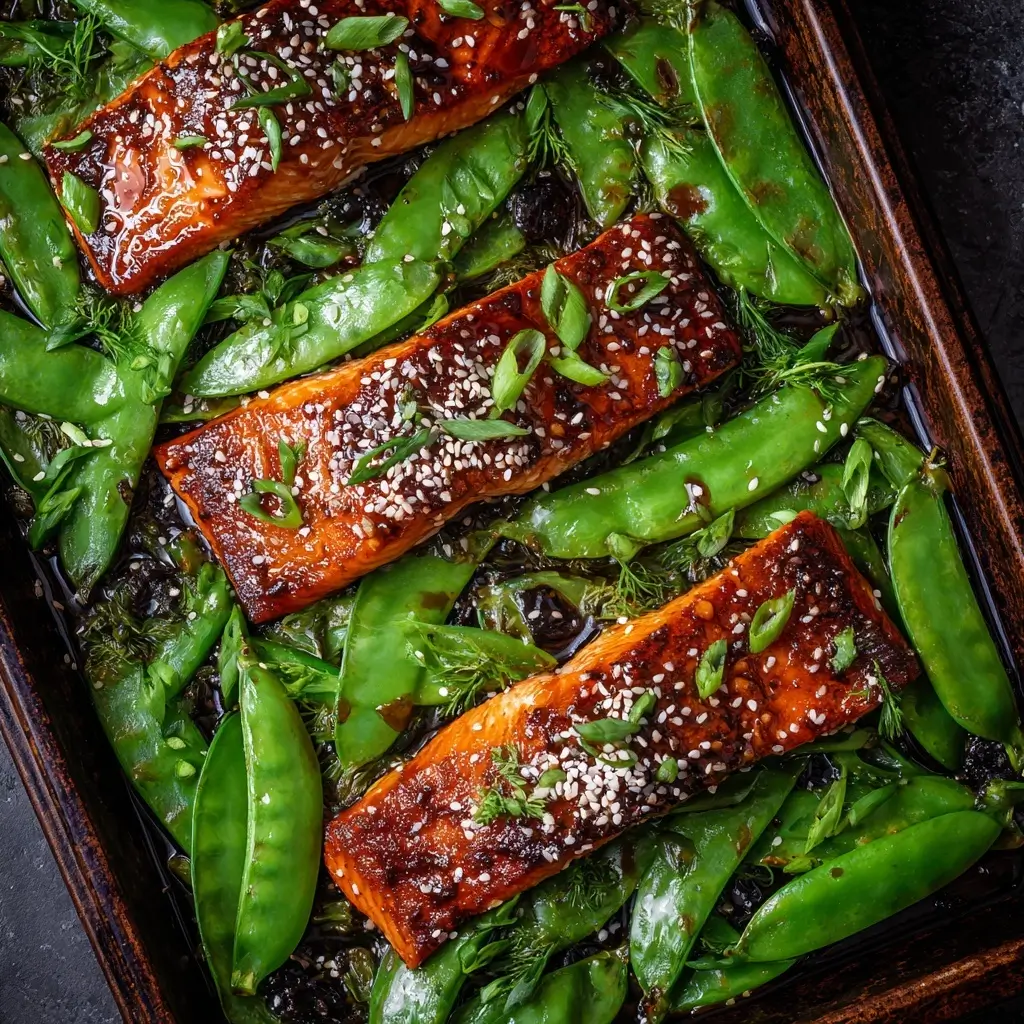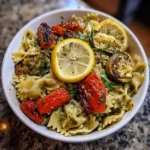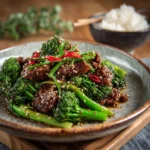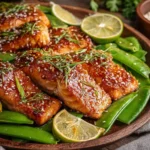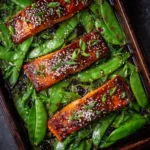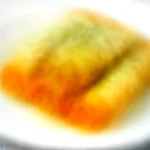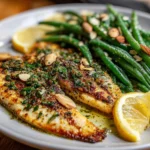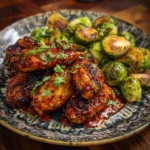Teriyaki Glazed Salmon Sheet-Pan with Snow Peas: A Complete Guide
Introduction
If you’re searching for a quick, nutritious, and flavorful weeknight dinner that requires minimal cleanup, look no further than this Teriyaki Glazed Salmon Sheet-Pan with Snow Peas. This dish combines the rich, buttery texture of salmon with the crisp freshness of snow peas, all brought together by a glossy, savory-sweet teriyaki glaze. Cooked entirely on one sheet pan, it’s a time-saving solution for busy home cooks who still want to enjoy restaurant-quality meals at home. Whether you’re cooking for yourself or your family, this recipe delivers vibrant flavors, beautiful colors, and balanced nutrition in under 30 minutes.
The History
Salmon has long been a staple in both Native American and Pacific Rim diets, prized for its high omega-3 content and rich flavor. In Japan, salmon (known as “sake” or “shake”) is often grilled or broiled and served with soy-based sauces, reflecting centuries-old culinary traditions. Teriyaki, which literally means “luster” (teri) and “grill” (yaki), originated in 17th century Japan as a method of grilling fish or meat glazed with a mixture of soy sauce, mirin, and sake. The technique gained global popularity in the 20th century, especially in North America, where Western palates embraced its sweet and salty profile.
The modern sheet-pan dinner trend emerged in the 2010s as a response to the growing demand for easy, one-dish meals that minimize prep and cleanup. Combining the traditional Japanese teriyaki method with the practicality of sheet-pan cooking results in a harmonious fusion of cultures and convenience. This Teriyaki Glazed Salmon Sheet-Pan with Snow Peas is a perfect example—a celebration of international flavors adapted for today’s fast-paced lifestyle.
Ingredients Breakdown
Every ingredient in this dish plays a crucial role in achieving balance between flavor, texture, and nutrition:
- Salmon fillets: Choose center-cut, skin-on fillets for optimal moisture retention and crispy skin when roasted. Wild-caught salmon offers richer flavor and higher nutrient density compared to farmed options.
- Snow peas: These tender, slightly sweet legumes add crunch and vibrant green color. They are low in calories but high in vitamins C and K, fiber, and antioxidants.
- Teriyaki sauce: Store-bought works in a pinch, but homemade gives better control over sweetness and sodium. Key components include soy sauce (or tamari for gluten-free), mirin, brown sugar or honey, garlic, and ginger.
- Olive oil: Helps prevent sticking and promotes even roasting while enhancing flavor absorption.
- Garlic and fresh ginger: Add aromatic depth and a subtle warmth that complements the sweetness of the glaze.
- Sesame seeds: For garnish—adds nuttiness and visual appeal.
- Lime or lemon juice: Brightens the dish with a touch of acidity to cut through the richness of the salmon and glaze.
Optional enhancements include sliced red bell peppers, broccoli florets, or carrots for added color and nutrition.
Step-by-Step Recipe
Follow these detailed instructions to achieve perfectly glazed salmon and tender-crisp vegetables every time:
Preparation (10 minutes)
- Preheat your oven to 400°F (200°C). Line a large rimmed baking sheet with parchment paper or aluminum foil for easy cleanup.
- Rinse the salmon fillets and pat them dry thoroughly with paper towels. Excess moisture can prevent proper browning.
- Trim any stringy ends from the snow peas. If desired, slice them diagonally for a more elegant presentation.
- Peel and mince 2 cloves of garlic and 1 tablespoon of fresh ginger.
Creating the Teriyaki Glaze (5 minutes)
In a small saucepan, combine:
- ¼ cup low-sodium soy sauce (or tamari)
- 2 tablespoons mirin (sweet rice wine)
- 2 tablespoons water
- 2 tablespoons brown sugar or honey
- 1 tablespoon rice vinegar
- 2 garlic cloves, minced
- 1 tablespoon fresh grated ginger
Bring the mixture to a gentle simmer over medium heat, stirring until the sugar dissolves. In a separate bowl, mix 1 teaspoon cornstarch with 1 tablespoon cold water to make a slurry. Whisk the slurry into the sauce and continue cooking for 2–3 minutes until slightly thickened. Remove from heat and set aside.
Assembling the Sheet Pan (5 minutes)
- On the prepared baking sheet, arrange the snow peas in a single layer on one side.
- Place the salmon fillets skin-side down on the other side, leaving space between each piece for even cooking.
- Drizzle 1 tablespoon of olive oil over the snow peas and season lightly with salt and pepper. Toss gently to coat.
- Brush about half of the warm teriyaki glaze generously over the top and sides of each salmon fillet.
- Scatter minced garlic and ginger over the snow peas for extra flavor infusion during roasting.
Baking (12–15 minutes)
- Place the sheet pan in the preheated oven and roast for 12–15 minutes, depending on the thickness of your salmon.
- The salmon is done when it flakes easily with a fork and reaches an internal temperature of 145°F (63°C).
- About halfway through cooking (after 7 minutes), remove the pan and use a silicone brush to apply a second coat of teriyaki glaze to the salmon.
- Stir the snow peas gently to ensure even roasting.
Finishing Touches
- Remove the pan from the oven. Let the salmon rest for 2–3 minutes.
- Squeeze fresh lime or lemon juice over the salmon and vegetables for brightness.
- Sprinkle toasted sesame seeds and thinly sliced green onions over the top for garnish.
- Serve immediately with steamed jasmine rice, quinoa, or cauliflower rice for a complete meal.
Tips
- Uniform sizing: Choose salmon fillets of similar thickness to ensure even cooking. If one is much thicker, tent the thinner pieces with foil halfway through.
- Don’t overcrowd: Leave space between ingredients to promote air circulation and prevent steaming.
- Glaze wisely: Reserve some glaze to drizzle at the end for maximum shine and flavor without burning.
- Check doneness: Use a food thermometer or flake test—salmon should be opaque but still moist inside.
- Toast sesame seeds: Lightly toast them in a dry skillet over medium heat for 1–2 minutes until golden for enhanced flavor.
- Use fresh aromatics: Fresh ginger and garlic provide superior taste compared to powdered versions.
- Cooking surface: Parchment paper prevents sticking and preserves non-stick pans; foil makes cleanup easier but may cause slight sticking.
Variations and Customizations
This recipe is highly adaptable to suit different tastes, dietary needs, and seasonal ingredients:
- Protein swaps: Replace salmon with skinless chicken thighs, shrimp, or firm tofu for a vegetarian option.
- Vegetable variations: Try asparagus, zucchini, bell peppers, broccoli, or green beans instead of snow peas.
- Spicy kick: Add a dash of sriracha or red pepper flakes to the teriyaki sauce for heat.
- Sugar-free version: Substitute brown sugar with monk fruit sweetener or stevia, and use sugar-free mirin substitute.
- Low-sodium option: Use reduced-sodium soy sauce and increase citrus or rice vinegar for tang.
- Keto-friendly: Omit sugar, use erythritol or allulose, and serve with cauliflower rice.
- Extra umami: Add a splash of fish sauce or a teaspoon of miso paste to the glaze.
- Fruit twist: Add pineapple chunks to the pan—they caramelize beautifully and enhance the sweetness of the teriyaki.
Health Considerations and Nutritional Value
This dish is not only delicious but also packed with health-promoting nutrients:
- Omega-3 fatty acids: Salmon is one of the best sources of EPA and DHA, essential fats known to support heart, brain, and joint health.
- Lean protein: Each 6-ounce fillet provides around 35–40 grams of high-quality protein, aiding muscle repair and satiety.
- Fiber and vitamins: Snow peas contribute dietary fiber, vitamin C (for immunity), vitamin K (for bone health), and folate.
- Antioxidants: Ginger and garlic offer anti-inflammatory and immune-boosting properties.
- Balanced macros: With healthy fats from salmon, complex carbs from optional grains, and plant-based fiber, this meal supports sustained energy levels.
Nutritional estimate per serving (1 fillet + veggies, without rice):
- Calories: ~380
- Protein: 38g
- Fat: 20g (mostly unsaturated)
- Carbohydrates: 15g
- Fiber: 4g
- Sodium: ~800mg (can be reduced with low-sodium soy sauce)
Note: Sodium content varies significantly based on the teriyaki sauce used. Homemade versions allow precise control over salt levels, making this dish suitable for those managing hypertension or heart conditions.
Ingredients
For the Salmon and Vegetables:
- 4 (6 oz) salmon fillets, skin on
- 12 oz fresh snow peas, trimmed
- 1 tbsp olive oil
- ½ tsp black pepper
- ½ tsp sea salt
For the Homemade Teriyaki Glaze:
- ¼ cup low-sodium soy sauce (or tamari)
- 2 tbsp mirin (or substitute with 1 tbsp rice vinegar + 1 tbsp sugar)
- 2 tbsp brown sugar or honey
- 2 tbsp water
- 1 tbsp rice vinegar
- 2 cloves garlic, minced
- 1 tbsp fresh ginger, grated
- 1 tsp cornstarch
- 1 tbsp cold water (for slurry)
For Garnish:
- 1 tbsp sesame seeds, toasted
- 2 green onions, thinly sliced
- 1 lime or lemon, cut into wedges
Directions
- Preheat oven to 400°F (200°C). Line a large baking sheet with parchment paper or foil.
- In a small saucepan, combine soy sauce, mirin, brown sugar, water, rice vinegar, garlic, and ginger. Simmer over medium heat for 3 minutes.
- Mix cornstarch with 1 tbsp cold water and whisk into the sauce. Cook 2–3 minutes until thickened. Remove from heat and set aside.
- Pat salmon dry and place skin-side down on one side of the baking sheet.
- Toss snow peas with olive oil, salt, and pepper; spread on the other side.
- Brush half of the teriyaki glaze over the salmon fillets.
- Roast for 7 minutes, then remove and brush with a second coat of glaze. Stir snow peas.
- Return to oven and bake 5–8 more minutes until salmon is flaky and cooked through.
- Rest for 2–3 minutes. Drizzle with remaining glaze if desired.
- Garnish with sesame seeds, green onions, and a squeeze of citrus. Serve immediately.
FAQ
Can I use frozen salmon?
Yes, but thaw it completely in the refrigerator overnight before cooking. Pat very dry to avoid excess moisture and steaming.
Can I make this ahead of time?
You can prepare the teriyaki sauce up to 5 days in advance and store it in the fridge. Assemble and cook just before serving for best texture.
How do I reheat leftovers?
Reheat gently in a 300°F oven for 10–12 minutes or in a skillet over low heat. Avoid microwaving, which can make salmon rubbery.
Is this recipe gluten-free?
Yes, if you use tamari instead of soy sauce and ensure your mirin is gluten-free (some brands contain wheat).
Can I grill this instead?
Absolutely! Grill the salmon over medium heat (skin-side down first) and toss snow peas in a grill basket. Baste with glaze during the last few minutes.
Why did my glaze burn?
Sugars in the glaze can burn at high heat. To prevent this, apply the glaze in layers and avoid excessive amounts on the first coat. Cover thin areas with foil if needed.
What sides go well with this dish?
Steamed jasmine rice, coconut rice, quinoa, fried rice, or a simple cucumber salad pair beautifully.
Summary
Delicious, nutritious, and ready in under 30 minutes, this Teriyaki Glazed Salmon Sheet-Pan with Snow Peas is a weeknight hero that brings bold flavors and effortless cleanup to your kitchen. Packed with omega-3s and vibrant veggies, it’s a balanced meal the whole family will love.
